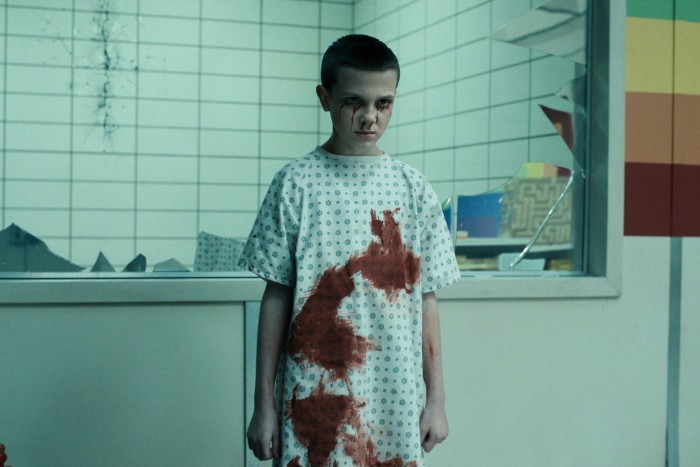“You’re going to see some crazy shit that you’ve never seen before,” says Stranger Things writer Kate Trefry, calmly sipping a cup of peppermint tea. “We’ve spent a lot of time figuring out how to play with people’s expectations of what theatre is — and how safe you are in your theatre seat.”
If that sounds terrifying, then that’s all to the good. Trefry is working on Stranger Things: The First Shadow, the new stage instalment of the hit Netflix series. The 1980s-set supernatural thriller, conceived by the Duffer Brothers, has been scaring people witless since it first appeared on the screen in 2016. Now it spreads its tentacles on to stage for the first time, sliding into London’s West End with what Trefry describes as “a bit of an origin story”.
The First Shadow spools back to 1959 and to early glimmers of something very nasty going on beneath the surface of small-town Hawkins, Indiana. Though it works as a standalone drama, the new play will offer Stranger Things fans a chance to explore the back-story of archvillain Vecna and to revisit beloved characters as teenagers. And, as with the original series, it’s a narrative that splices a coming-of-age story about love and friendship with psychological chiller and sci-fi horror.
“So much of the DNA of the show is balancing the mundane with the supernatural,” says Trefry. “If it feels like a slasher movie, then we’ve failed. So we’ve adopted a similar structure for the play. The first sequence you see is wild. Then we go back to the neighbourhood and start to see how it all connects.”
Louis McCartney (left, as Henry Creel) and Patrick Vaill (as Dr Brenner) © Manuel Harlan
For her, the psychological territory is as important as the paranormal: “That’s been core to the show since the beginning. You have your Demogorgon, but you also have Dr Brenner, and for years we’ve been exploring the idea of who’s the real monster.
“The stage show is very much playing into that world. This is a play about fear: the destructive, corrosive, insidious nature of fear and its role in creating a supervillain . . . Doubt is a really rich place to put down some claws and make a mess.”
Stranger Things is not the only show putting down some claws this winter. In another rehearsal space across town, writer Paul Unwin and director Angus Jackson are crafting The Enfield Haunting, a new play based on the bizarre story of poltergeist activity in a modest terraced house in 1970s London. Meanwhile, after several successful West End seasons, 2:22 A Ghost Story has set out on tour to terrify theatregoers nationwide.
I think there is a feeling of triumph and release that comes from enduring something that really pushes your buttons
The history of theatre is haunted by spectres, monsters and other supernatural beings — from the ghost in Hamlet to the blood-chilling tales in Conor McPherson’s The Weir and the hair-raising horrors of The Woman in Black, which ran for 33 years in the West End.
 From left: David Threlfall (Maurice), Ella Schrey-Yeats (Janet) and Jude Coward Nicoll (Jimmy) in rehearsals for ‘The Enfield Haunting’ © Craig Sugden
From left: David Threlfall (Maurice), Ella Schrey-Yeats (Janet) and Jude Coward Nicoll (Jimmy) in rehearsals for ‘The Enfield Haunting’ © Craig Sugden
So what’s the attraction? Why do we enjoy scaring ourselves silly? “I think there is a feeling of triumph and release that comes from enduring something that really pushes your buttons,” says Trefry. “You feel like you gain tools that help you deal with real fear, real terror.”
But on stage, that comes with a risk. Theatrical ghouls can walk a narrow tightrope between the terrifying and the tacky. And the extra challenge for the creative team of the Stranger Things show is to find a stage equivalent for the TV series’ blood-curdling effects. The show will be pushing multiple technical boundaries, says Trefry.
“We have a ton of special effects. But it’s been a process of throwing everything up at the wall and then paring back dramatically to how little we can do to make it as scary as possible. That’s where the really horrifying moments live.”
In theatre, less is often more. And while you might not have CGI, you do have the collective imagination and spontaneous response of several hundred people, together with the immediacy and proximity of live theatre.
“Because this is live, we want to exploit that inherent feeling of danger,” explains Trefry. “There is no TV screen keeping you safe from the action that is happening in this room with you.”
 Millie Bobby Brown as Eleven in ‘Stranger Things’ © Courtesy of Netflix
Millie Bobby Brown as Eleven in ‘Stranger Things’ © Courtesy of Netflix
Being in the same space as the action can be petrifying. Gregory Doran’s 1999 production of Macbeth suddenly plunged its audience into pitch darkness for the witches’ scenes. In Punchdrunk’s The Crash of the Elysium, participants were chased down corridors by vengeful stone angels. Live drama always relies on suspension of disbelief and the complicity between actors and audience — bring in a supernatural element and you can achieve something bone-chilling.
In The Enfield Haunting, that blurred line between reality and illusion — between what we see and what we believe we see — becomes crucial not only to the delivery of the narrative, but to the subject it explores. In the late 1970s, stories emerged of disturbing poltergeist activity pegged to two north London schoolgirls, Janet and Margaret Hodgson. The case became famous, attracting huge media attention and specialist interest.
The new dramatisation has compressed the events into one night in 1978. “It’s very faithful, but it’s not documentary,” says director Jackson. “It’s 90 minutes straight through, no interval, so once you strap in, it’s like a rollercoaster ride. There’s no time to stop and consider — just as the people involved didn’t have time to stop and think.”
The new staging of this true story will deploy sophisticated effects — courtesy of illusionist Paul Kieve — but, as with Stranger Things, the creative team suggests the deepest impact should lie in the storytelling. Effects need to be embedded in the narrative, says Jackson: “You try to avoid being a vaudevillian entertainment.”
Again the story plunges into the whirlpool of adolescence and the uncertainty and instability that accompanies it. The two girls at the heart of the poltergeist story were living in turbulent political times and their parents had just divorced.
For Unwin, that doesn’t explain away what happened, but it means we can understand it on several levels. “It’s not that they kid themselves,” he says. “We all know when we lie to ourselves. But then there’s a deeper thing where we are totally convinced. Emotions can make you think things, believe things and do things that just tower above what we might expect.
“I think what happened in that house was a lot of multiple layers of emotional energy and need, which probably triggered some very strange events. In the play there are very real, natural, world forces on the girls. And then there are other elements going on which are less explicable.”
Unwin adds that ghost stories are often popular in troubled times: there’s something helpful about facing down fear, grief and incomprehensible events together. And the live element of theatre can be so potent that, even if you know a story inside out, it can still terrify you. That’s certainly the case for Trefry.
“I have had the privilege of writing [Stranger Things: The First Shadow], rehearsing it and teching it,” she says. “And still it gets me every time.”
‘Stranger Things: The First Shadow’, Phoenix Theatre, London, from November 17, strangerthingsonstage.com
‘The Enfield Haunting’, Theatre Royal, Brighton, November 14-18; Richmond Theatre, Richmond, November 21-15; Ambassadors Theatre, London, November 30-March 2, enfieldhauntingplay.com
‘2:22 A Ghost Story’, currently on UK tour, 222aghoststory.com
https://www.ft.com/content/6fbfb6f6-49c0-4468-b85e-35855f7da3ad




